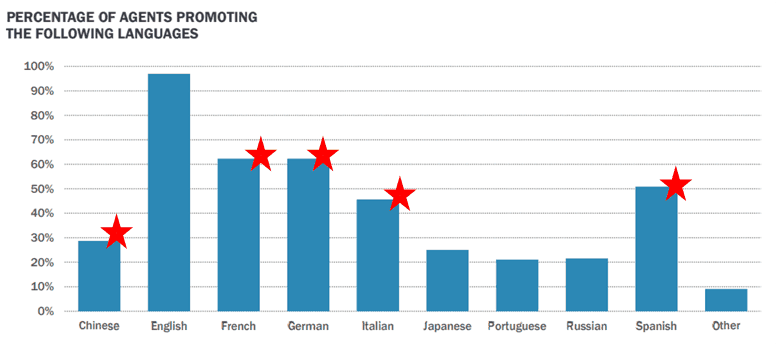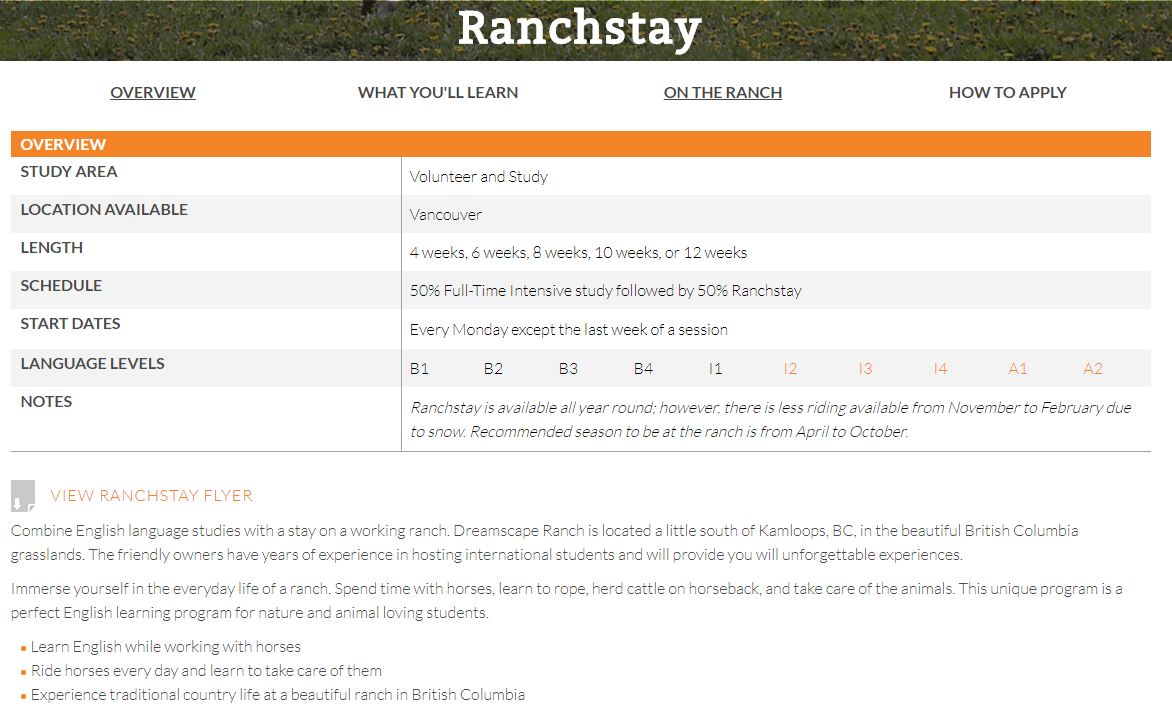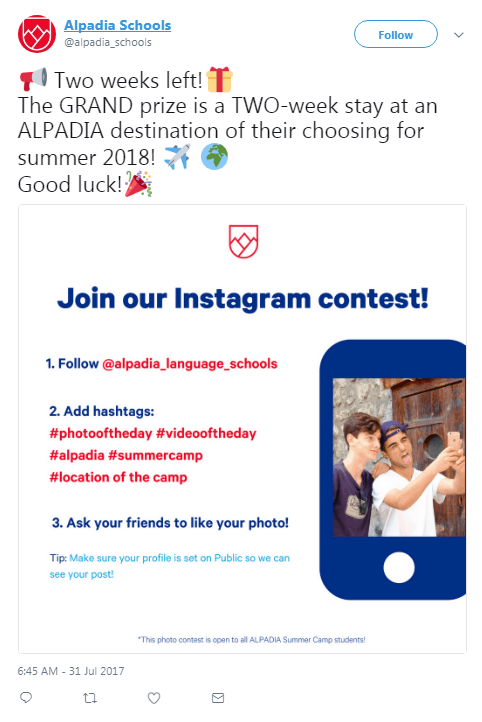
While English remains the most in-demand language for education, countless students around the globe are eager to learn other languages. ESL Language School Marketing offers non-English courses, and may wonder: How do you market to these students when most marketing advice is ESL-centric? And how do you demonstrate the advantages of learning a different language when English is so popular?
If you’re facing this challenge, you’re in the right place. In this blog, we’ll provide handy advice for determining the unique advantages of the language your school teaches, the types of individuals who may be interested in studying that language, as well as tactics for how to effectively reach out to prospective students and generate leads for your programs using your school’s digital channels.
Trends in Demand for Language Courses and How They Impact Your School
A 2016 report by the International Association of Language Centres (IALC), Trends in the Demand for Foreign Languages, offers several enlightening insights into the demand for non-English language training. According to the report, while English courses will remain the most popular option and will see continued growth, that growth is expected to slow slightly, and demand for non-English courses will increase.
As globalization continues to make the need for multilingualism more prominent than ever before, an increasing number of individuals are interested in learning another language. Between 2012 and 2015, 56% of agents who participated in the study experienced an increased demand for German courses, and 41% reported growing demand for both Spanish and French. Other languages that have also seen growth include Italian and Chinese.
It’s no surprise that the languages mentioned above are the most heavily promoted by agents (aside from English), further demonstrating the increasing demand for more diverse language training options.

Source: International Association of Language Centres
Both Italian and Spanish share Language for Academic Study and Language + Activity as their most popular course options. For Chinese, Language for Academic Study and School Trips with Language Learning programs take the cake, while the most popular programs for both French and German are Language for Academic Study and Summer Camps for young learners.

Source: International Association of Language Centres
By knowing which types of programs are the most popular for each language, you can tailor your course offerings to better tap in to your potential market.
Promoting the Unique Selling Points of a Language through Language School Marketing
In order to persuade students to study the language your school offers, you need to communicate its value. Every language has its own advantages that make the investment of time, money, and effort to learn it worthwhile. By effectively communicating these unique selling points through your language school marketing efforts, you can work towards generating more leads and enrolments. The first step, though, is determining the language’s unique benefits.
First, you should consider why individuals choose to study a certain language. Spanish, for example, is one of the most widely spoken languages in the entire world, especially in Latin America, Spain, and the USA. Therefore, it’s fair to assume that students taking Spanish courses could be enrolling for a range reasons, such as business or travel purposes.
On the other hand, Italian—which is only spoken in a small area of the world by a small population—is likely to be learned for purely personal reasons, whether the student dreams of speaking a Romance language, has Italian heritage, or loves to travel to Italy.
According to the IALC study, most students seek out German courses for their current and future studies, French for personal, employment, and education reasons, and Chinese for improving employment prospects.
Once you’ve determined the unique selling points of the language you are promoting, you can tailor your school’s digital marketing messaging around those points.
Example: IH Madrid promotes its language courses by creating blogs outlining why achieving a Spanish certificate benefits prospective students’ careers.

Understanding Your Prospective Students and Their Interests
There are many types of students that attend language schools. By developing student personas based on your typical and ideal students, which outline their needs, concerns, and motivations, it will be easier for you to focus your language school advertising and marketing efforts to speak directly to their interests.
One common market for language schools is the over-50s. These are individuals who are likely to be close to retiring or retired, have a large amount of expendable income, enjoy travelling and immersing themselves into new cultures, and may be looking to learn a new language to enhance their life and take up a new hobby.
At the other end of the scale, another popular market is gap-year or exchange students. These individuals are likely travelling to a country temporarily to experience the culture and attractions, study, and learn a new language. Promoting how your programs will allow them enough flexibility to experience the destination, or promoting the attractiveness of the destination itself, will speak to their unique interests.
These are just two examples of many possible student personas. Other student personas could include business professionals and executives who need language training for work, parents hoping to send their children to language camp or language lessons for young learners, immigrants, and others.
Using Inbound Marketing to Promote Non-English Language Courses
In order to create interest in your language courses, your school needs to demonstrate the advantages of learning the language in general and at your school in particular. One of the best ways to do so naturally and authentically is by using your language school branding and inbound marketing for language education initiatives to create a unique identity and messaging tailored to your target personas’ aspirations. This can include blog posts, social media messages, curated content, press releases, email newsletters, contests, and other digital channels.
Example: Alpadia Language Schools offers both French and German language courses for adults and children. Using its social media channels, the school generates interest in their courses through a contest.

Through promotional content like blogs, social media, and email marketing, you can discuss a range of topics that will appeal directly to your target audience. If you’re promoting general language courses, for example, you might create content about how learning the language will help your target audience in various aspects of life, about attractions in the city your school is located in, or perhaps even about obtaining a study visa. On the other hand, if you’re promoting a test preparation course, you might discuss test-taking techniques or how the course will help better prepare the potential applicant for the exam.
To best appeal to your student base, it’s important to consider the language you should be creating promotional content in. If you offer courses in your country’s language, you will most likely already have developed content in that language on your website. Still, it may be worth considering creating multilingual content to appeal to prospective students. For most language schools, creating content in English is the most appropriate for the widest audience.
Example: ActiLingua Academy offers German courses in Vienna, and discusses why students should study in Vienna instead of in a German city in this blog. Users can view site content in either English or German.

If you are planning to target a specific market, it may be more beneficial to produce content in their native language. However, it’s important to remember that if you’re producing content or advertising in a certain language, your school needs to be able to follow up with students in that language, and may need native speakers on staff. If students contact your school hoping to speak to someone in their native language after seeing your content and there’s no one available, you could run the risk of losing them as a prospect.
Employing Paid Language School Advertising to Reach Prospective Students
If you’re looking to spread the word about your programs and courses quickly, paid advertising can be very effective. Using PPC campaigns on platforms like Google AdWords or Bing, you can target your ads so your school is visible when your ideal target audience is searching for information about language training. This can be a very fruitful strategy for schools looking to promote languages other than English, as they can target their campaigns by location, age, and other factors in order to zero in on their particular niche market.
When using a paid advertising campaign, always make sure the ad opens to a designated landing page with enough information to entice interest, and a lead capture form, so you can turn the prospective student into a formal lead and follow up with them. Again, it’s important to consider what language the campaign should be in, and ensure that the landing page is in the same language as your ads.
Example: Kappa Language School uses a Google Adwords campaign to promote its Italian language classes in Rome.

The campaign is paired with a designated landing page featuring a lead capture form.

When it comes to promoting non-English language courses, the key is to communicate the value that learning the language brings, and how your programs and courses will help students uncover that value. Understanding the unique concerns and motivations of your target audience will allow you to create content that is relevant and helps move the prospective student closer to enrolment. In addition, keeping up-to-date with trends surrounding the language you teach and what the preferred courses are will help you offer courses best suited to the needs of your target markets.
FAQ To Consider
How do I market my ESL school?
In order to persuade students to study the language your school offers, you need to communicate its value. Every language has its own advantages that make the investment of time, money, and effort to learn it worthwhile.






